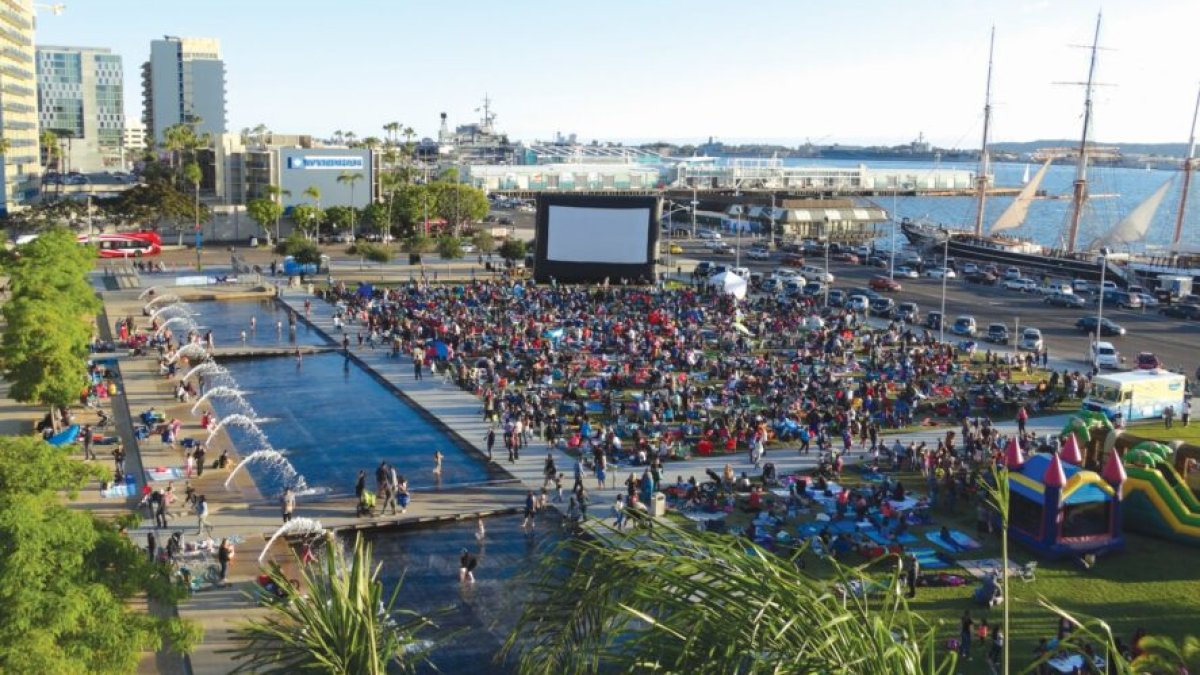Politics
Israel's religious right has a clear plan for Gaza: 'We are occupying, deporting and settling'
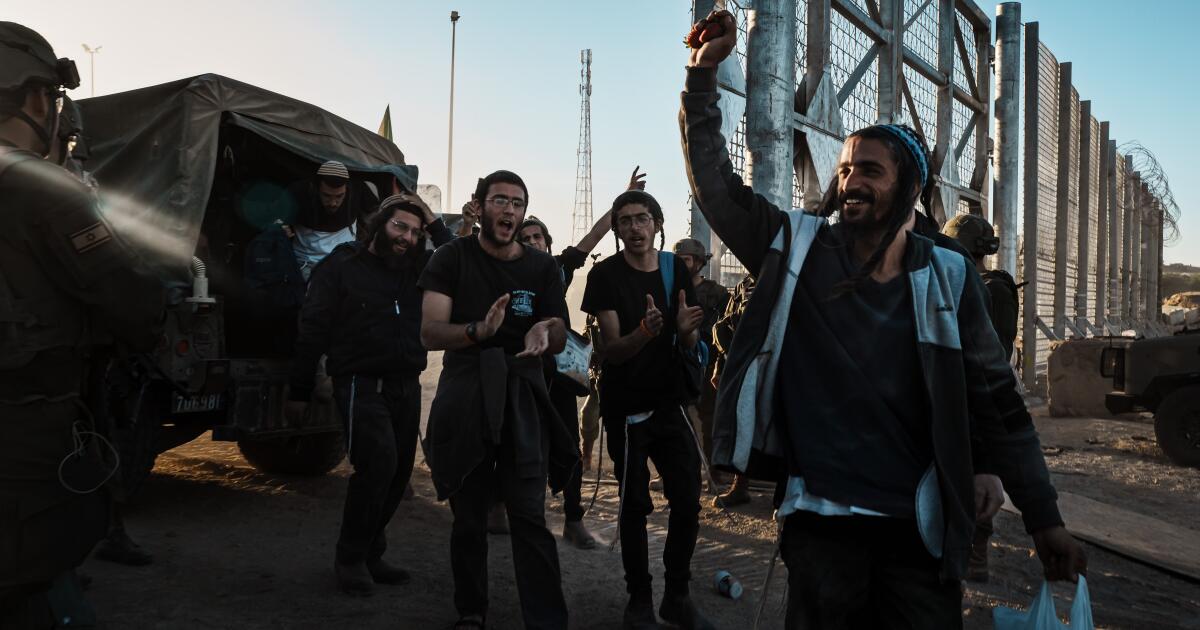
Carrying planks of plywood, a group of Israeli settlers pushed past soldiers guarding the barrier surrounding the Gaza Strip and quickly got to work. Within minutes, the young men had erected two small buildings — outposts, they said, of a future Jewish settlement in the war-torn Palestinian enclave.
Their movement had hungered for this moment for years, but now, after Oct. 7, they felt it was just a matter of time before Jews would be living in Gaza again. “It is ours,” said David Remer, 18. “[God] said it is ours.”
1
2
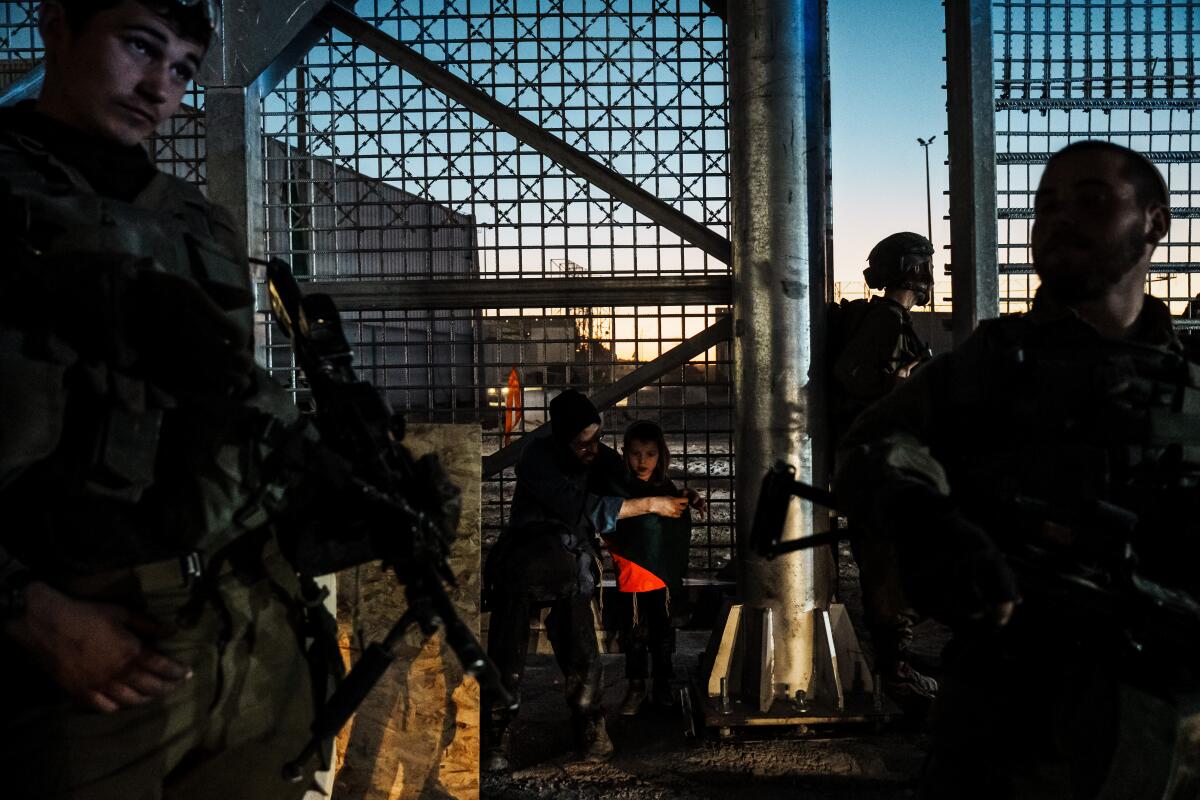
3

1. Protesters march to a border checkpoint in Kerem Shalom, Israel, hoping to block aid shipments into war-torn Gaza. 2. Israeli troops stand by at Erez Crossing as activists try to enter the military buffer zone into Gaza. 3. Israeli troops remove a protester from a sit-in intended to block shipments of aid into the Gaza Strip.
Religious Zionists, who believe the Jewish people have divine authority to rule from the Jordan River to the Mediterranean Sea, make up only around 14% of Israel’s population. But in recent years they have greatly expanded their influence in the military, the government and society at large, and their often extremist ideology is helping shape Israel’s war against Hamas.
Although they are not politically homogeneous, most religious Zionists embrace far-right views. They loudly oppose a cease-fire deal to bring home Israeli hostages, and have repeatedly blocked humanitarian assistance from entering Gaza by standing in front of aid trucks.
They see the deadly Oct. 7 Hamas-led attack on Israel as proof of their longtime assertion that peace cannot be made with the Palestinians, and view Gaza as a territory that they have a religious obligation to conquer. Increasingly, they have called for the expulsion of the 2.3 million Palestinians living there.
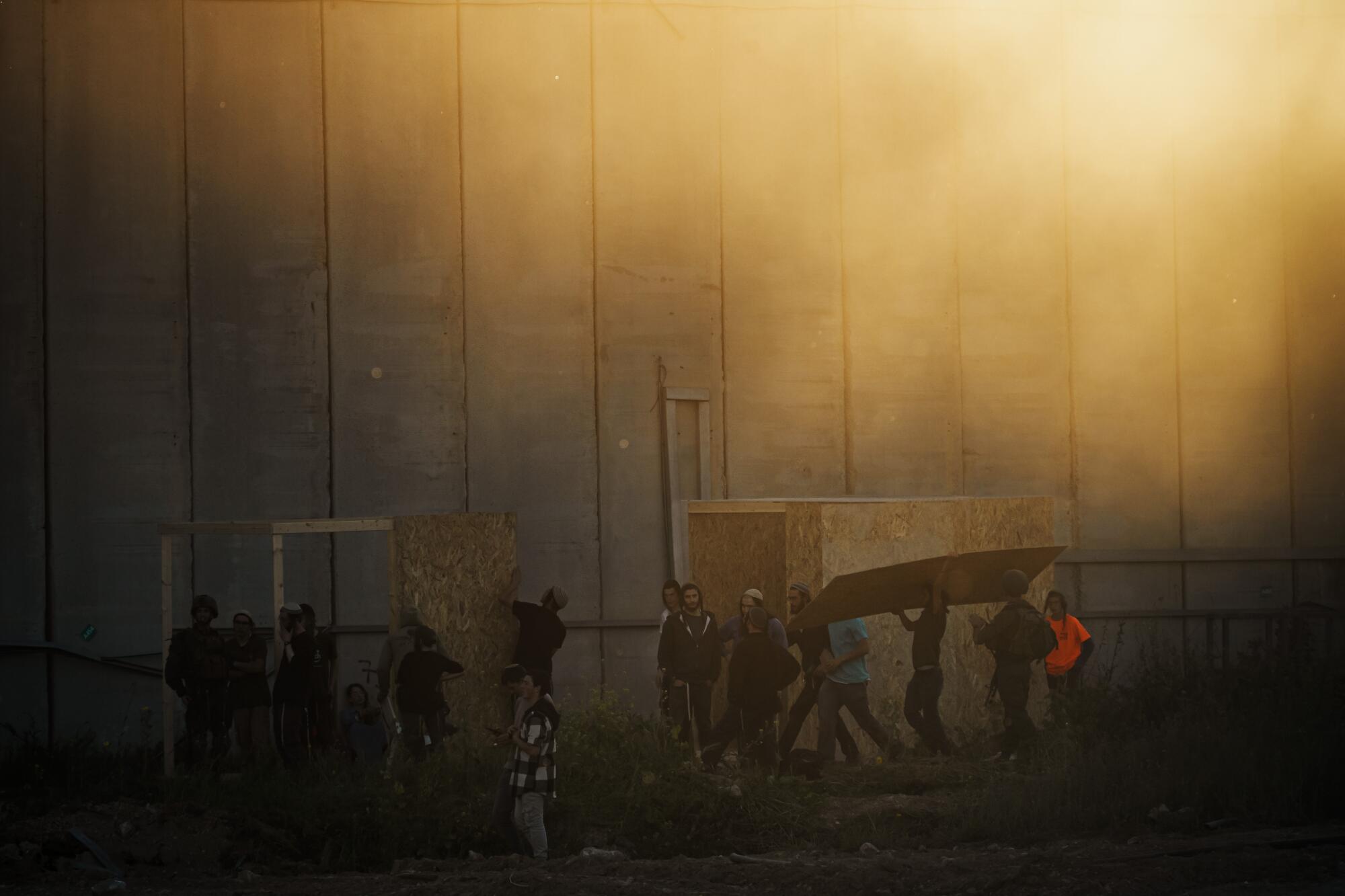
Jewish settler activists hastily erect outposts inside the Israeli military’s buffer zone for the Gaza Strip at the Erez crossing.
First, they dream of reestablishing Gush Katif, a bloc of Jewish settlements that existed in Gaza until Israel withdrew from the enclave in 2005.
It’s a goal embraced by some of the top leaders in Israel’s far-right government, many of whom appeared at a recent Jerusalem rally pushing for Gaza’s resettlement. While videos played showing Israel’s brutal military assault on the enclave and organizers shared brochures promising new houses with views of the Mediterranean Sea, National Security Minister Itamar Ben-Gvir sang religious songs alongside participants and told them: “Now is the time to return home.”
On the battlefield, some religious soldiers have recorded themselves dancing with Torah scrolls and waving the orange flags of Gush Katif. Other combatants travel with mezuzahs, small boxes containing biblical Scriptures meant to be hung outside Jewish residences, to affix to Palestinian homes.
Reuven Gal, former chief psychologist for the military and a researcher at the Israel Institute of Technology, says that for many soldiers, the Gaza conflict that has killed more than 30,000 Palestinians is “not just a military operation.”
“For them,” he said, “it’s a holy war.”
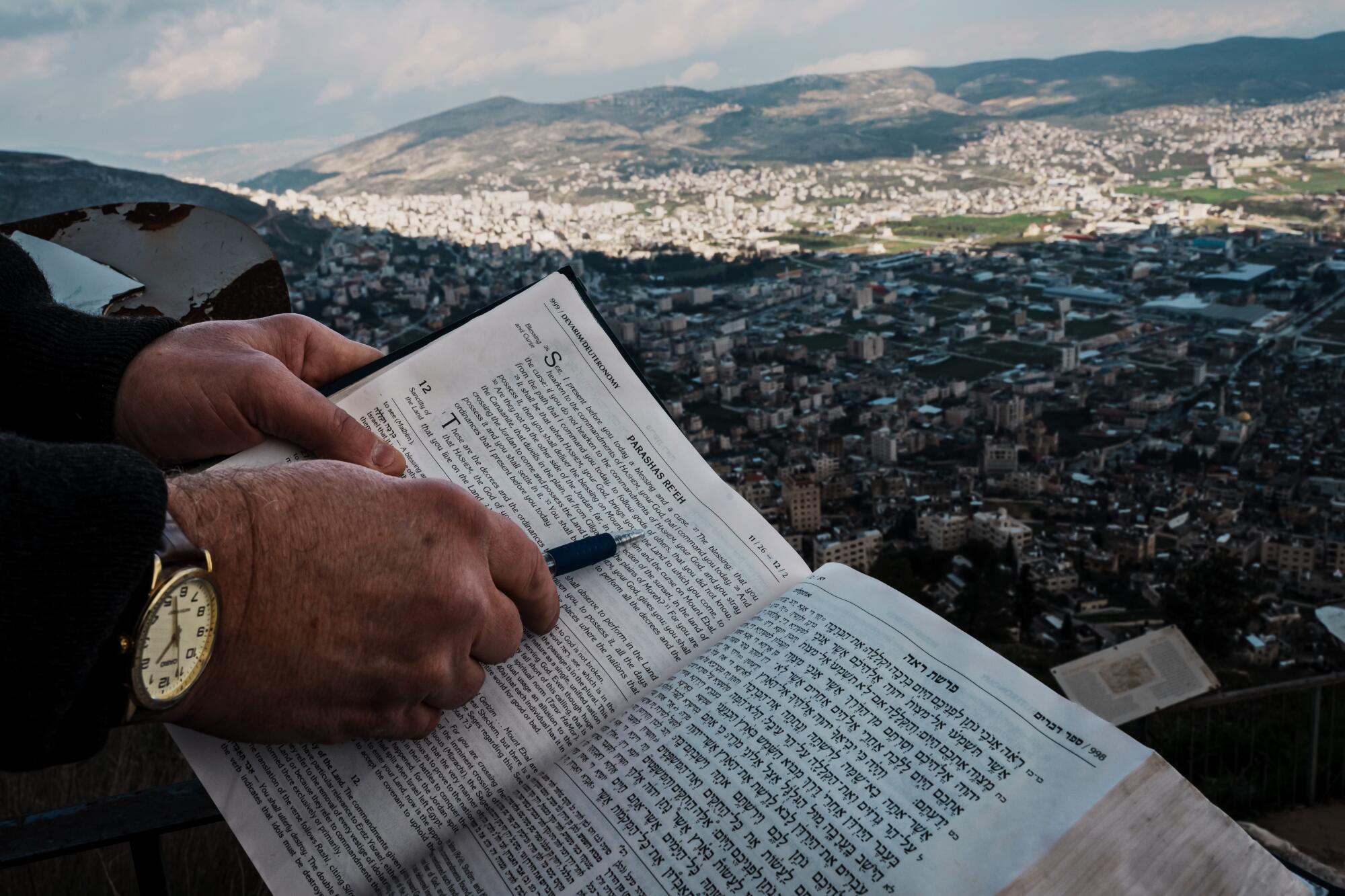
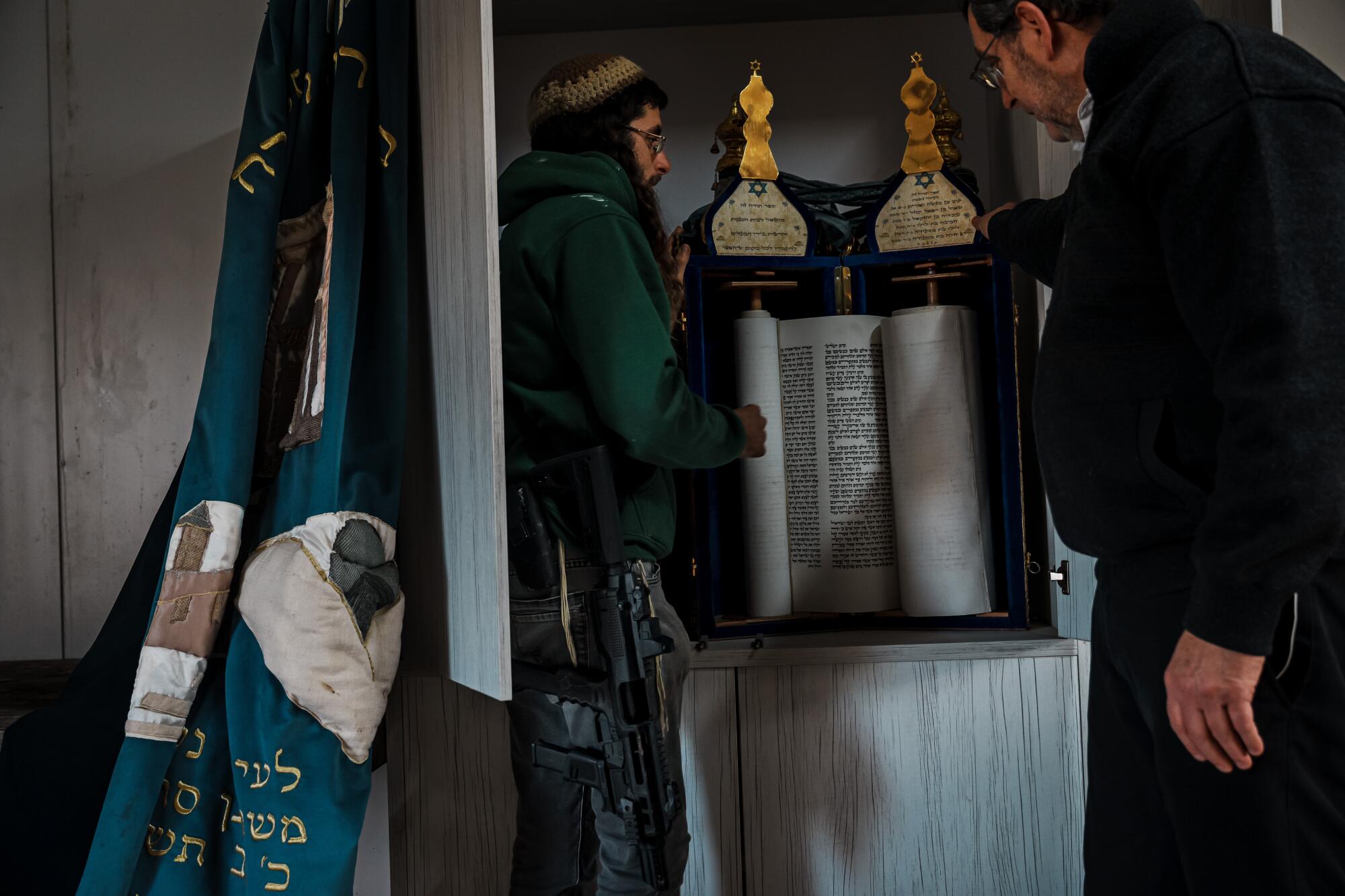
Top, Settler Avraham Sheinman, overlooking Nablus in the West Bank from Mt. Gerizim, points out passages in his Torah that he says show Jews have a religious obligation to conquer Palestinian territories. Bottom, Yishai Sheinman, left, and father Avraham Sheinman uncover the Torah in a synagogue in Yitzhar, West Bank. Yishai, 27, belongs to a violent extremist group devoted to expanding Israeli control of the region.
Yair Margolis, an army reservist who was called up from his yeshiva studies last year to fight in Gaza, said during a recent break from battle that the war had a clear spiritual dimension.
“Going back to that land is returning home,” he said. “This is where we are from, and this is what we are fighting for.”
It’s a vision starkly at odds with Israel’s mainstream, even as the country’s political center has shifted discernibly to the right in recent years. A January poll by Israel’s Channel 12 broadcaster found that 51% of Israelis oppose building Jewish settlements in Gaza, compared with 38% who support doing so.
1
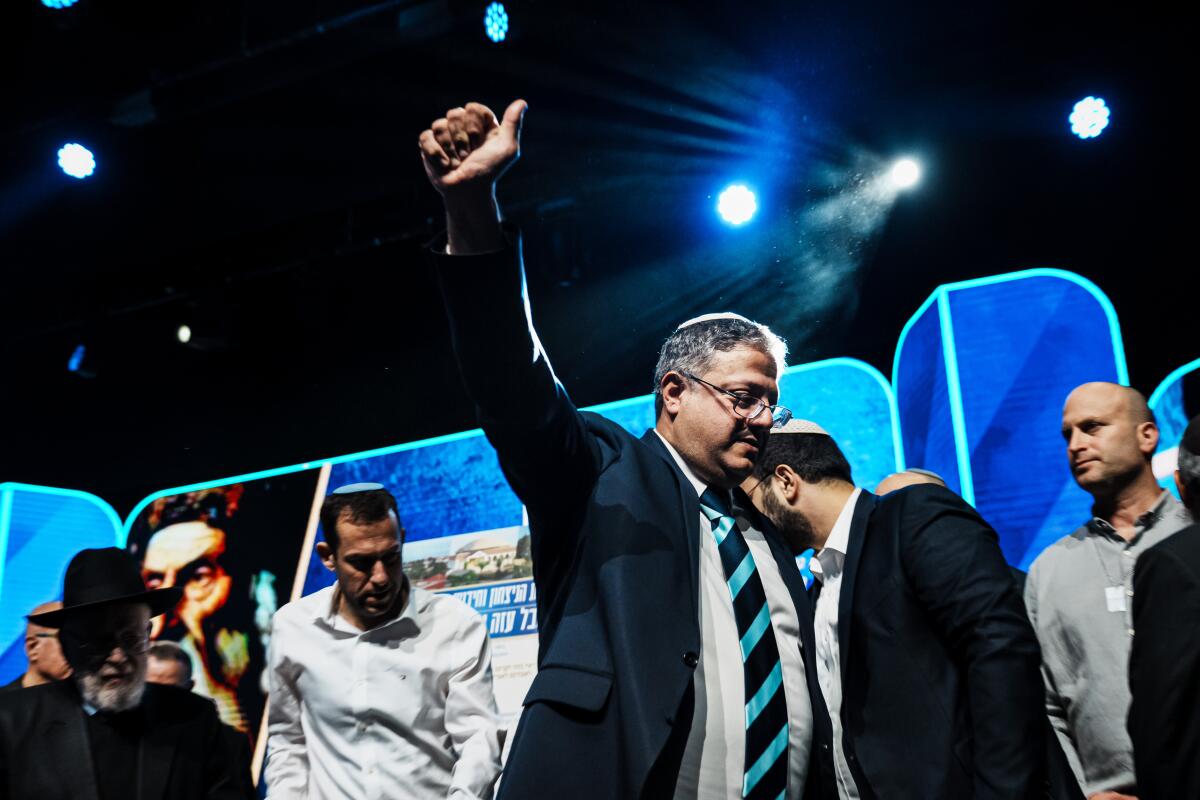
2

1. Israel’s national security chief and leader of the far-right Jewish Power Party, Itamar Ben-Gvir, center, called at a recent convention for rebuilding Jewish settlements in Gaza and expanding those in the occupied West Bank. 2. The crowd celebrates at the Jerusalem convention, organized by far-right activists seeking expansion onto more Palestinian land.
Prime Minister Benjamin Netanyahu, a right-wing populist, has called settling Gaza “unrealistic.” But in 2022, as his ongoing corruption trials left him isolated, Netanyahu made a deal with several religious Zionist parties to form a coalition government, and his political future is now closely tied to theirs.
Beyond a pledge to maintain indefinite military control over Gaza and eventually turn over administrative duties to Palestinians, Netanyahu’s postwar strategy remains murky, leaving a vacuum, political analysts say, that the religious right is eager to fill.
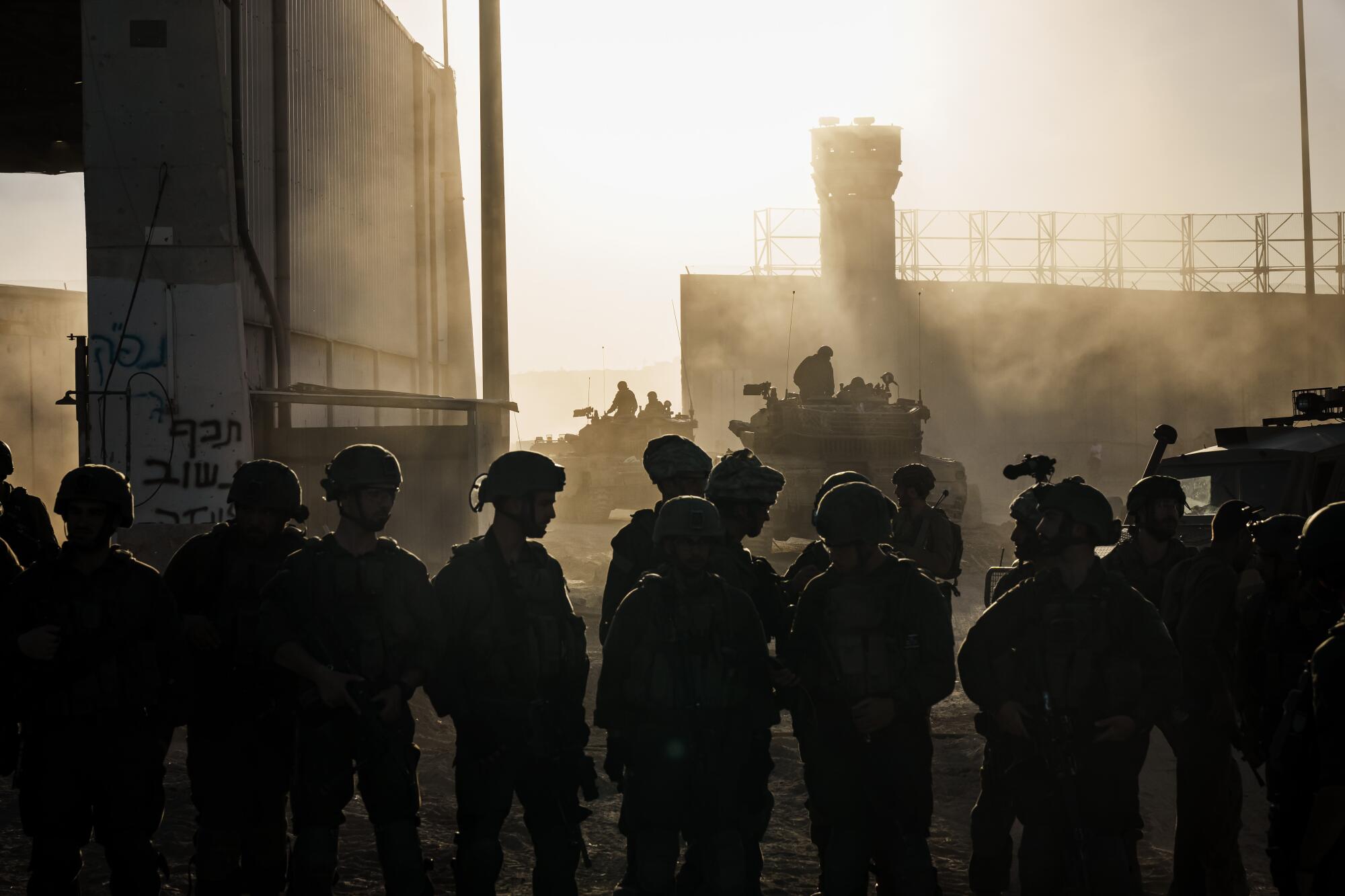
Israeli forces arrive at the Erez border crossing next to the northern Gaza Strip.
In a recent video from Gaza circulated on social media, an Israeli soldier dressed in camouflage stands smiling with a machine gun in front of a bombed-out building. He directly addresses Netanyahu, who is widely known by his nickname “Bibi.”
“We are occupying, deporting and settling,” the soldier says. “Do you hear that, Bibi?”
::
During the war in 1967, Israel captured a wide swath of Palestinian land that included the West Bank, East Jerusalem and the Gaza Strip.
Almost immediately, Jewish settlers began establishing communities in each of them, displacing Palestinians who lived there.

Tuvia Levy, far right, and Marom Harel, center, look over Palestinian towns from a security outpost in Yitzhar, West Bank. Both men live in West Bank settlements and were called up for reserve duty after Oct. 7.
While the settler movement isn’t composed just of religious people, and over the years it has received backing from both right- and left-wing Israeli governments, it is ideologically driven by practitioners of Orthodox Judaism who believe God gave what they call the Land of Israel exclusively to the Jews.
Unlike the ultra-Orthodox, some of whom oppose the Zionist project and decline to serve in the military, religious Zionists embrace the teachings of rabbis who say believers have a spiritual imperative to expand Israel’s borders.
By 2005, around 8,000 mostly religious Zionists were living in Gaza, often in neighborhoods that resembled Southern California subdivisions, with their orderly rows of red-tile-roofed homes. The settlements were heavily guarded by the military, and residents frequently clashed with their Palestinian neighbors.
Amid growing concerns about high casualties among the troops tasked with protecting the settlements, Prime Minister Ariel Sharon ordered a complete Israeli withdrawal from the enclave. Sharon, who was a supporter of settlers in the West Bank, now instructed soldiers to forcibly remove them from Gaza.
The “disengagement” from Gaza, with its scenes of screaming settlers being pulled from their homes and synagogues, was transformative for religious Zionists. Many vowed to gain more influence in the traditionally secular institutions they felt had betrayed them.
“For them it was a traumatic event,” said Yagil Levy, a professor of political sociology at the Open University of Israel. “They want to erase this trauma by any means.”
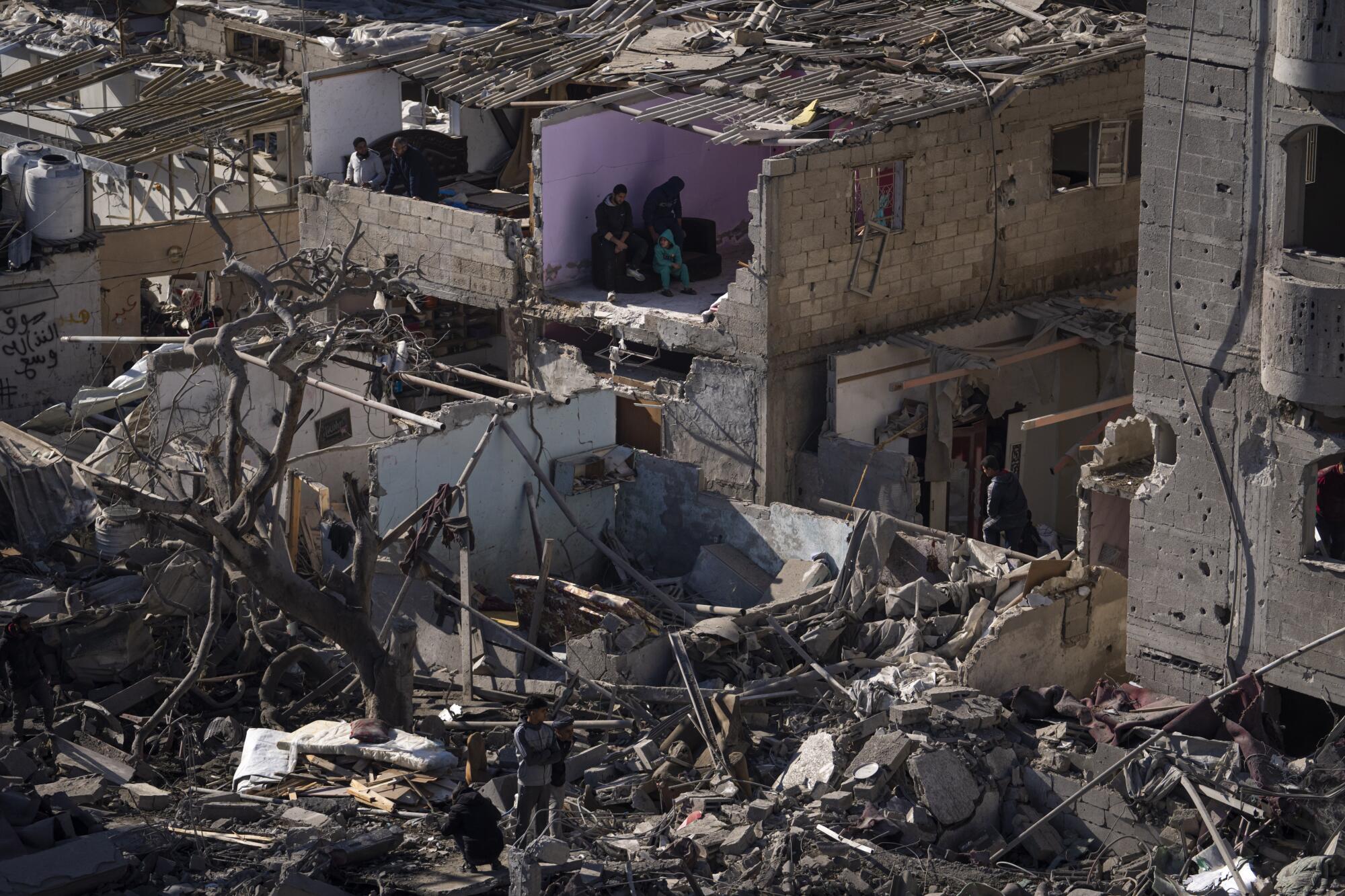
Palestinians take in the rubble left by an Israeli airstrike on residential buildings and a mosque in Rafah, Gaza Strip.
(Fatima Shbair / Associated Press)
That meant building a political movement that has sought “to push the government as far right as it can go” and “completely demolish any talk of a Palestinian state,” said political scientist Dahlia Scheindlin. Over time, she said, ideas that once seemed extreme — like expanding settlements in the West Bank — became normalized.
Helping their cause were the country’s changing demographics: Religious Zionists, like the ultra-Orthodox, were having children at a much higher rate than their secular peers.
At the same time, they were making new inroads in the army.
The military academy that has become the West Point for the religious right is built atop a wind-swept hill in the West Bank settlement of Eli. Here, young men wearing yarmulkes spend their days studying both the Torah and military strategy.
For many years, religious Zionist families were hesitant for their sons to fulfill Israel’s mandatory three-year army service, worried that exposure to secular peers would erode their faith. This school, Bnei David, promised to minimize that risk, offering teenage boys a chance to fortify their religious beliefs before entering the military. Its website boasts of starting a “quiet revolution in the Israel Defense Forces.”

Students are taught that God “wants a people of Israel, and there is no state of Israel if there isn’t a strong army,” said Rabbi Eli Sadan, the school’s founder. They’re also taught by instructors who oppose the presence of women in the military and who have described gay people as “sick and perverted.”
Speaking from behind a large desk strewn with rabbinical texts, Sadan said he supports a scorched-earth military strategy in Gaza, “so Israel’s enemies will see the ruins and think: ‘I don’t want to mess with the Jews.’”
He is against the rebuilding of Palestinian society in Gaza, where at least half of all buildings have been damaged or destroyed during Israel’s fierce bombing campaign. “We must eliminate the possibility of Gazans returning,” he said, arguing that displaced civilians should be forced to live in tents for many years until they decide “to emigrate willingly.”
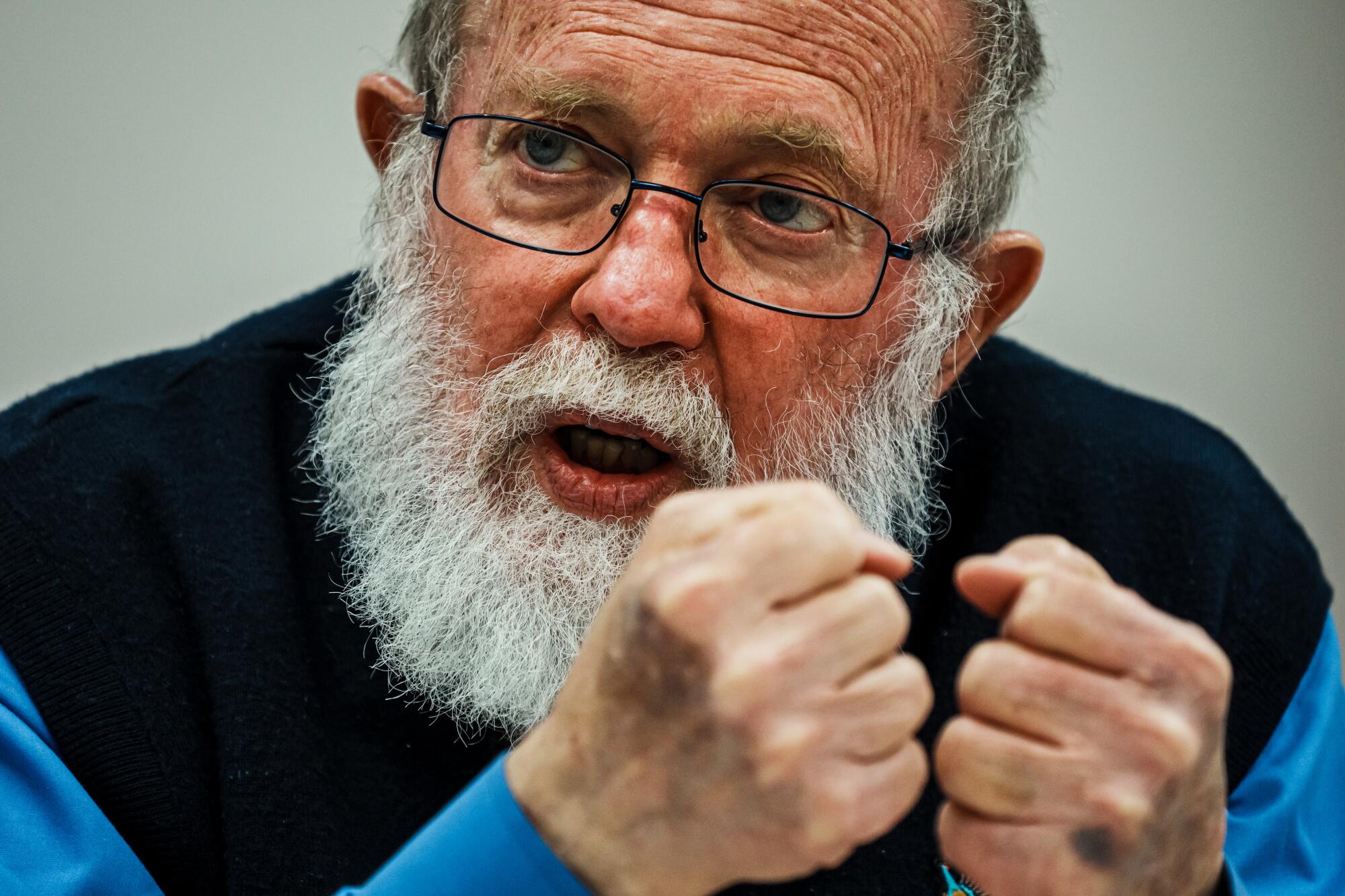

Top, Rabbi Eli Sadan, the founder of the Bnei David military academy, said he supports a scorched-earth strategy in Gaza. Bottom, Students attend a class in a room at Bnei David that honors alumni who died serving in the Israeli military. The school has lost 18 former students in the Gaza war.
Sadan said his school, which recently hosted events with both Netanyahu and Israel’s defense minister, has produced 3,000 soldiers, more than 50% of whom have risen to the rank of officer or higher. Since the conflict broke out, 18 alumni have died in Gaza.
The rise of religious military academies like this one has dramatically changed the makeup of the army, said Levy, the sociologist. Religious Zionists made up about 3% of officer school graduates in 1990, Levy’s research shows; in 2018, they accounted for over a third.
Levy, who has written about what he calls the “theocratization of the Israeli military,” said the trend has caused conflicts, with some religious soldiers refusing to serve alongside women.
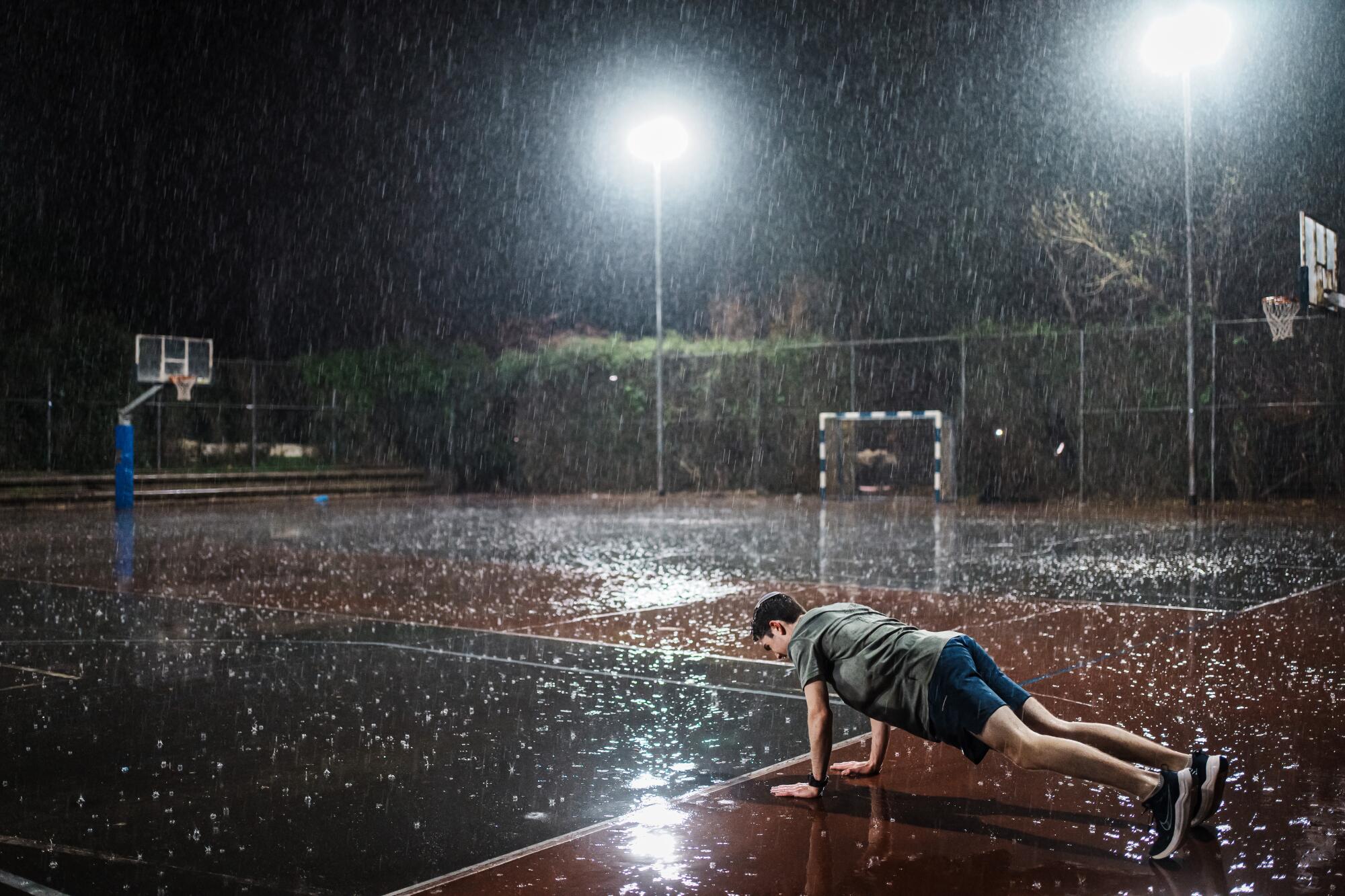
A student does push-ups at the religious and military academy for religious Zionists.
A pressing question, he said, is whether religious soldiers would comply with orders to forcibly remove Jewish residents from a settlement — a scenario that could play out under the creation of a Palestinian state.
Sadan said he teaches his students to always heed commands from military superiors. But during the 2005 disengagement from Gaza, other rabbis called on soldiers to refuse orders, and some did.
“What we see is growing resistance in the ranks,” Levy said. “They’re trying to challenge the formal codes of the military.”
::
Those hoping to establish Jewish settlements in Gaza say they will model their strategy on the West Bank, where today 500,000 settlers live among 3 million Palestinians.
Since Oct. 7, tensions here have been simmering as the line between settlers and soldiers has become increasingly blurred.

Reservist Yosef Shalom Sheinman, 30, was called up after Oct. 7 to help protect Jewish settlements in the West Bank, where he lives.
After the Hamas attack in southern Israel killed around 1,200 people, hundreds of thousands of Israeli reservists were called up for duty. Many reservists in the West Bank were instructed to don uniforms and guard their own communities.
Among them were Yosef Shalom Sheinman, 30, who is from Har Bracha, a mountain settlement overlooking the Palestinian city of Nablus.
Sheinman’s parents helped found Har Bracha in 1987 amid protests from Jewish leftists and the Palestinians who once grazed sheep here. His younger brother, 27-year-old Yishai, belongs to a famously violent extremist group known as the Hilltop Youth, which is devoted to expanding Israeli control of the region. “These are kids who would eat Arabs for breakfast,” their father says proudly.
For decades, Israeli soldiers have been deployed throughout the West Bank to protect existing settlements, which most of the world considers illegal under international law. But the soldiers are also often instructed to stop the building of illegal settlement outposts. In the past, they sometimes clashed with Yishai Sheinman, tearing down new outposts he and his friends had erected.
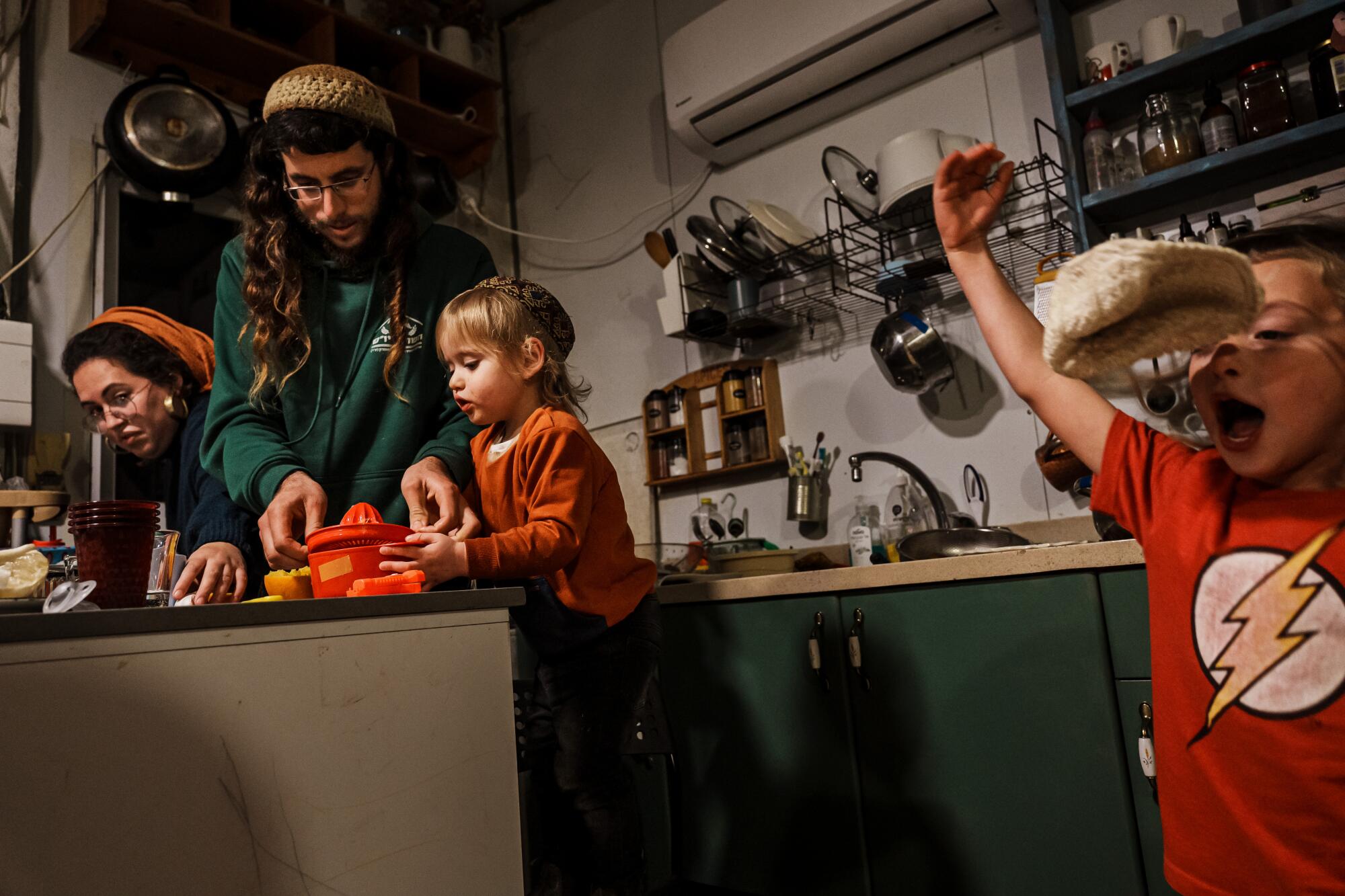
Like many religious Zionists, Yishai Sheinman, his wife, Rashid, and their children live in a settlement on Palestinian territory despite the disapproval of Washington and international law.
Now many of the soldiers in the region are his friends — or, in the case of his older brother, his family.
The reservists are not curtailing settlement expansion, the older brother said. Instead, they’re focused on patrolling nearby Palestinian villages — and making sure they aren’t growing. His unit recently cut a new road through a stretch of hillside between a Palestinian hamlet and Har Bracha, in effect claiming the area for the settlement.
“This is our land,” he said. “And God is with us.”
On a recent afternoon, Sheinman stood with his father, Avraham, taking in views sweeping from the peaks of Jordan to the skyscrapers of Tel Aviv. Avraham Sheinman clutched a well-worn Torah, which he consulted frequently to highlight passages that he says show Jews have a religious obligation to be here. “We have a commandment to conquer it,” he said.
He spoke of a war with Palestinians, but also of “an inner war” within Israel.
“Who are we? What direction are we going?” he asked. “Are we going in the direction of our destiny as a chosen people in the Land of Israel — as a Jewish state according to Jewish law? Or are we a secular leftist copy of Europe or America?”
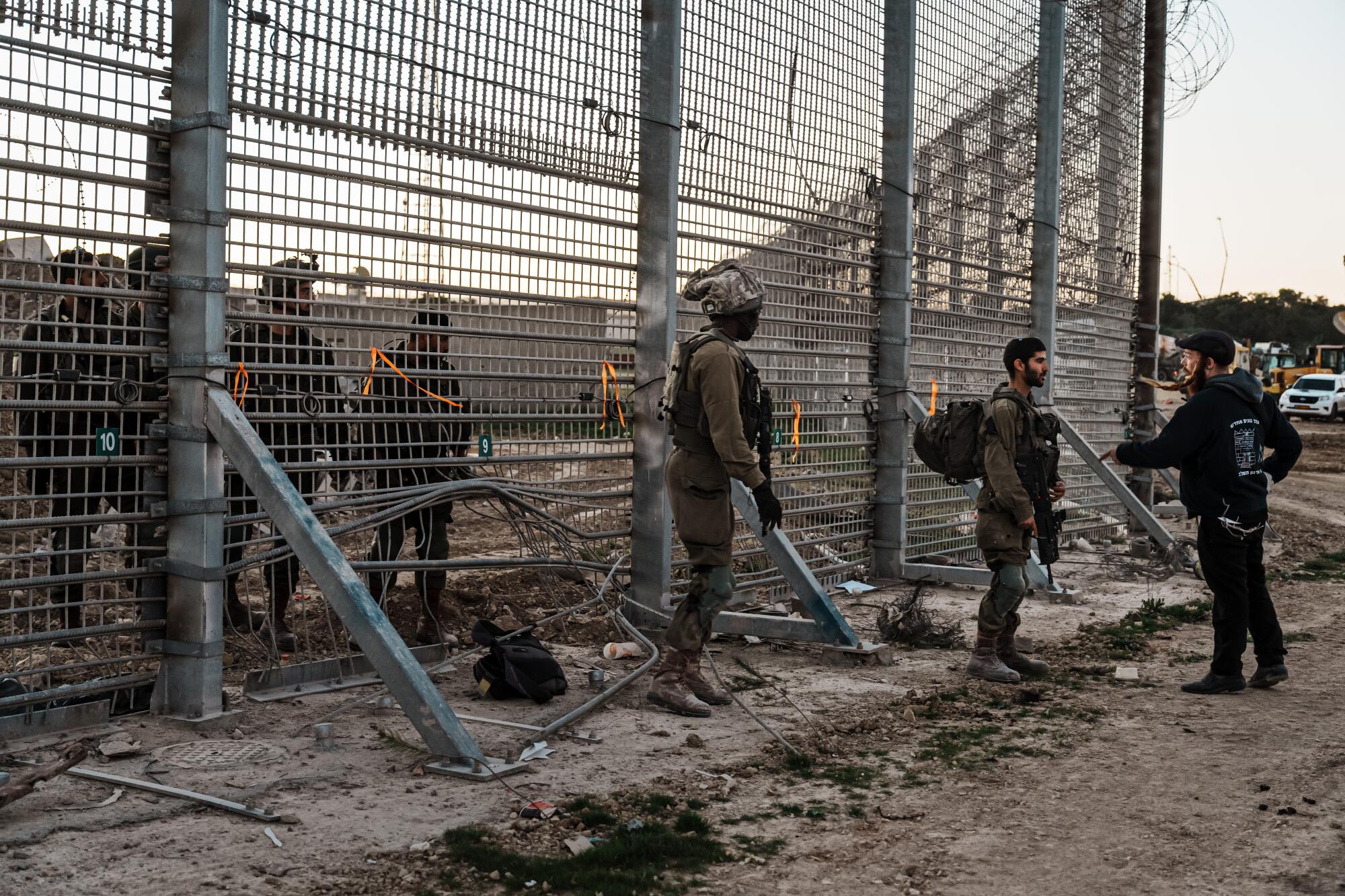
Israeli troops try to to stop one of many far-right activists from entering the Erez Crossing military buffer zone into Gaza.
Many on the other side of the political divide view that question with the same urgency.
In an interview with Sky News this month, writer and historian Yuval Noah Harari said the biggest threat to Israel is not Hamas, Hezbollah or Iran, but Jewish extremism: “There is really a battle for the soul of the Israeli nation between patriotism on the one side and ideals of Jewish supremacy on the other.”
It is too early to say exactly how the Hamas attack and the Gaza war will shape that debate. But early indications suggest they have awakened new support for the right.
Protests near the Egyptian border to halt aid delivery into Gaza were first organized by religious Zionists, but now draw secular participants. And while much of the international community holds out hope that the West Bank, East Jerusalem and Gaza will one day be recognized as a Palestinian country, faith among Israelis in a two-state solution has dimmed.
A Tel Aviv University poll found that support for peace negotiations among Israeli Jews had fallen from 48% just before the Hamas attacks to 25% a few weeks after.

Supporters of Jewish settlements talk with Israeli troops in an effort to enter war-ravaged Gaza.
Leaders of the religious right, meanwhile, are using the war as an opportunity to push through extreme policies.
Ben-Gvir, the national security chief, leads the Jewish Power party and has helped arm thousands of Israeli civilians by relaxing restrictions on gun ownership. Finance Minister Bezalel Smotrich, head of the Religious Zionist Party, recently announced plans to expand settlements in the West Bank by more than 3,000 homes. Both Smotrich and Ben-Gvir, who has been convicted of inciting racism and supporting terrorism, live in the West Bank.
Life for Palestinians there has gotten markedly worse since Oct. 7, with more than 600 settler attacks against Palestinians recorded since the war broke out, according to the United Nations, and more than 1,200 Palestinians displaced from their homes.
Palestinian activist Issa Amro lives in the historic center of Hebron, the largest city in the West Bank, in the midst of a heavily guarded Jewish settlement.
On the day of the Hamas attack, he was returning from work when several neighbors surprised him in an olive grove and began assaulting him. Some, he said, wore army uniforms probably left over from their military service.
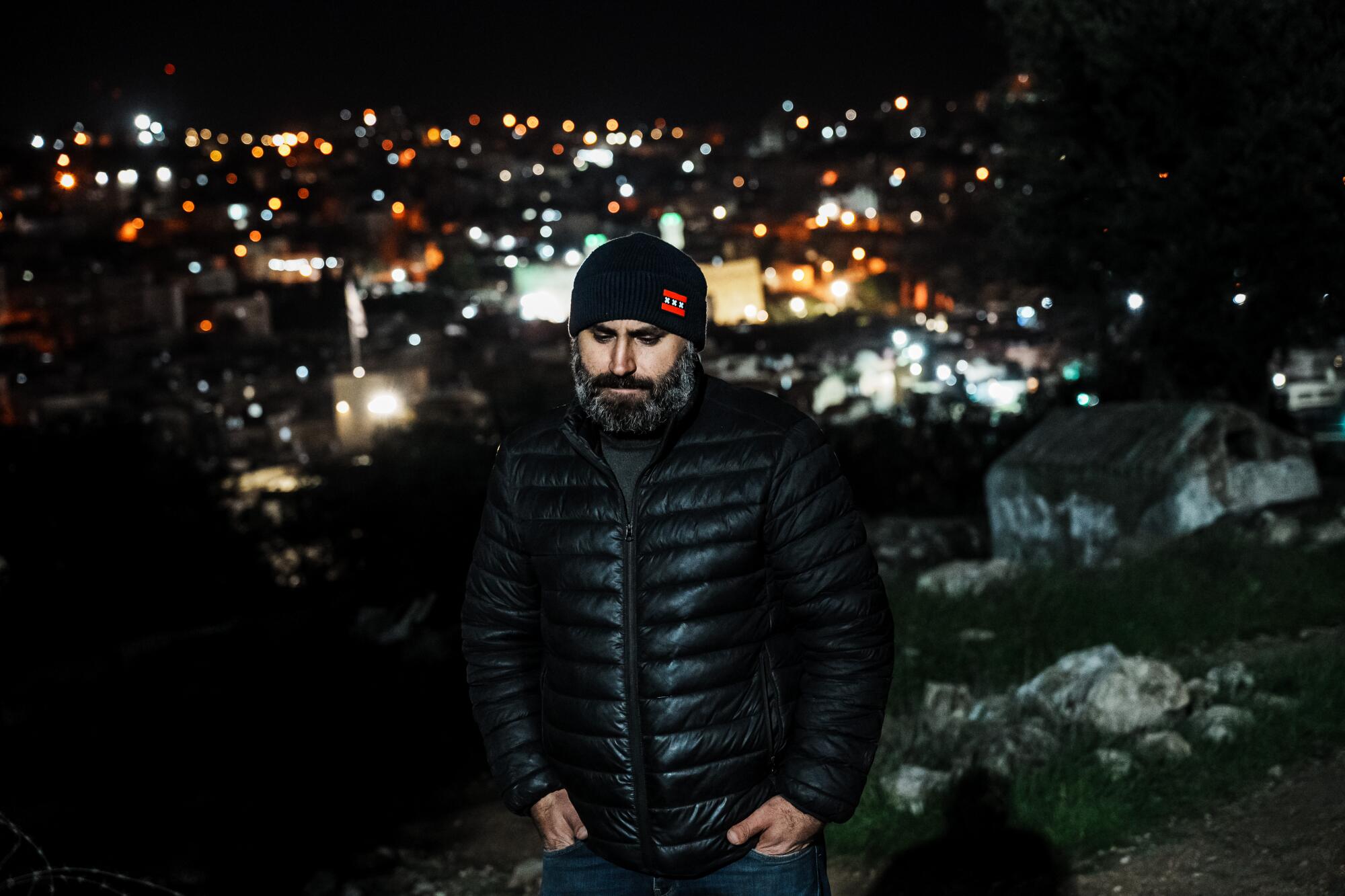
Palestinian Issa Amro says he has lived in fear since he was assaulted by settlers, then detained and beaten at a military base. He’s surrounded in Hebron, West Bank, by a heavily guarded settlement.
Amro was then taken to a military base, where he says he was detained for 10 hours and beaten.
He said he lives in fear. Every day he passes former Palestinian businesses shuttered by settlers, as well as a sign that says: “We’re occupying Gaza now.”
“Every meter I walk, I think I may be shot,” he said.
Amro said he doesn’t blame the settlers so much as the political leaders who have allowed the settlements to flourish. He pointed to Netanyahu, who allied with Ben-Gvir and Smotrich, and to Donald Trump, who as president abandoned Washington’s long-held position that West Bank settlements violate international law. “Netanyahu made them mainstream,” Amro said. “The Trump administration made them mainstream.”

An Israeli soldier orders Palestinian children in the West Bank city of Hebron to go back inside, barring them from playing on the street.
President Biden has since reversed the U.S. stance on West Bank settlements — and recently imposed sanctions on four Israeli settlers for carrying out violence against Palestinians. And Secretary of State Antony J. Blinken says Washington opposes the reoccupation of the Gaza Strip by Israel and any reduction of the Palestinian territory’s size.
Joel Carmel, a former Israeli soldier who is now a peace activist, said the future of Jewish settlements in Gaza may depend on who wins the U.S. election in November.
“Probably the only thing holding back the resettlement of Gaza is the Biden administration,” he said. “And who knows how long that’s going to last.”
Many Palestinians in the West Bank think it’s only matter of time before Israeli settlers move permanently into Gaza.
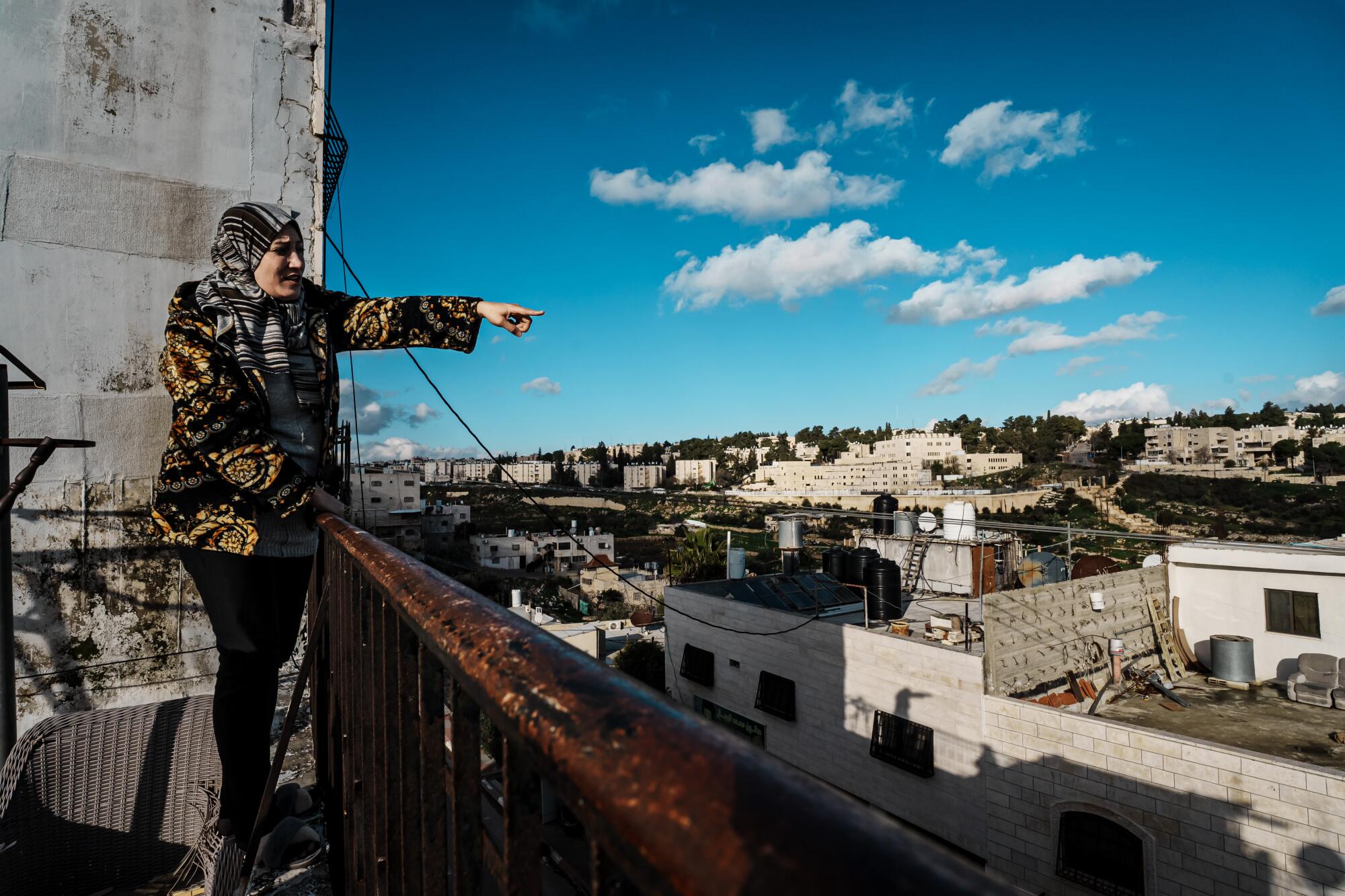
Areej Al Jaabari, who lives in Hebron, West Bank, points toward the settlement where Israel’s national security minister lives.
Areej Al Jaabari, a mother in Hebron, has watched as settlements have crept ever closer to her family home. Ben-Gvir lives in a sprawling suburban community she can see from her living room window.
“They’re gradually accomplishing their goals,” she said of the settlers. “Eventually they will control everything in Gaza too.”
Linthicum reported from Jerusalem and from Yitzhar, Har Bracha and Hebron in the West Bank. Times staff photojournalist Marcus Yam contributed to this report from Erez Crossing, Israel.

Politics
California beach ‘Resist!’ protest pushes ‘kindness’ while calling to ‘86 47’ in anti-Trump message
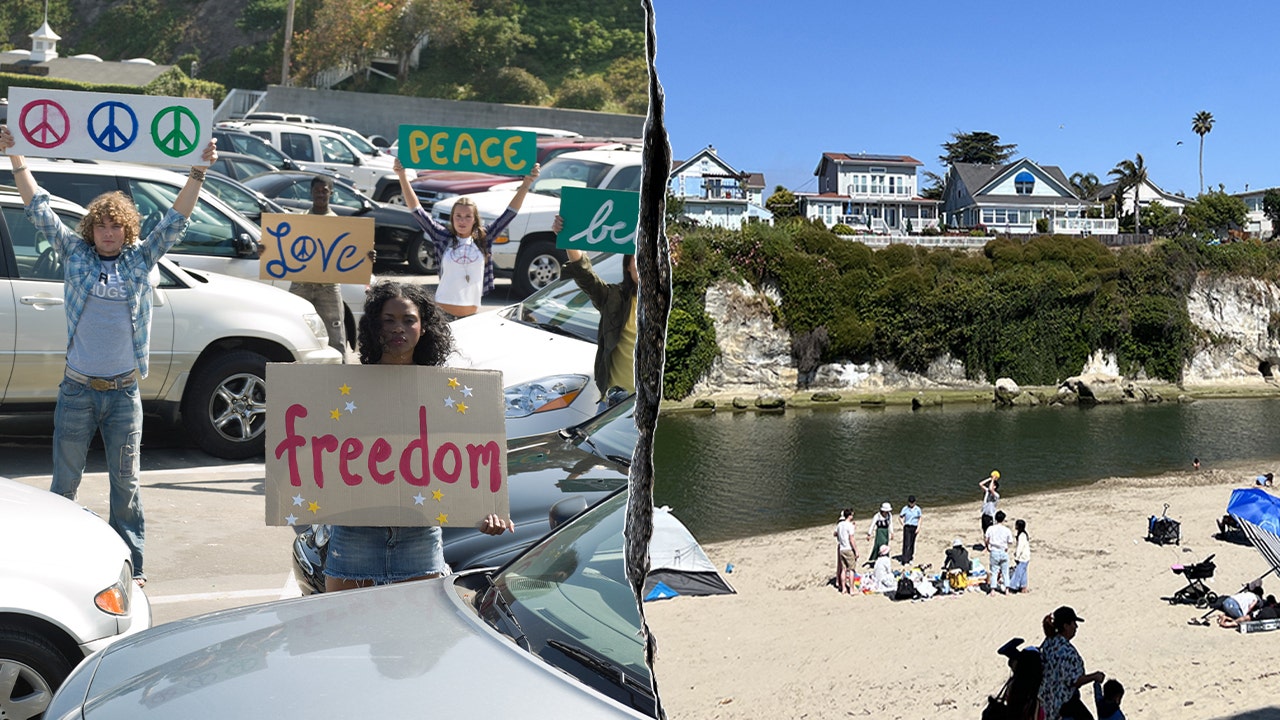
Nearly 1,000 people gathered at Main Beach in Santa Cruz, California, on Saturday for a Pride Month protest aimed squarely at President Donald Trump.
Participants formed a massive human banner that spelled out “Resist!” in rainbow colors as part of a demonstration organized by Indivisible Santa Cruz County.
The 220-foot-wide display, with letters reaching 70 feet high, was designed by longtime left-wing activist Brad Newsham.
Organizers described the event as a peaceful act of resistance and a show of solidarity with the LGBTQ+ community.
SEATTLE MAYOR ACCUSED OF LYING AFTER BLAMING CHRISTIAN RALLY FOR PARK VIOLENCE
Left: Protesters hold signs reading “Peace,” “Love,” and “Freedom.” Right: Beachgoers gather near coastal homes along the cliffs at Main Beach in Santa Cruz, California. The area was the site of a large-scale protest against President Donald Trump organized as part of the city’s Pride celebration. (iStock and Getty Images)
“It’s very important, the more people [who] can show our neighbors, our politicians in the world, that nonviolent resistance is the way to express our dissatisfaction with the way our country’s going,” said event organizer Becca Moeller to Lookout Santa Cruz.
But just above the colorful banner was a very different kind of message: “86 47,” a phrase many interpreted as a call to “get rid of” the 47th President of the United States.
In slang, “86” typically means to cancel, eliminate, or even destroy. Combined with “47,” the number now associated with President Trump’s second term, the phrase has raised alarms among critics who say it crossed a line.
Earlier this month, former FBI Chief James Comey posted a similar message in the sand, but instead of kelp, they were shells. He has since removed the post after widespread criticism and action by law enforcement.
SEATTLE MAYOR BLAMES CHRISTIAN RALLY FOR INSPIRING VIOLENT ‘ANARCHISTS’ WHO ‘INFILTRATED’ COUNTER-PROTEST
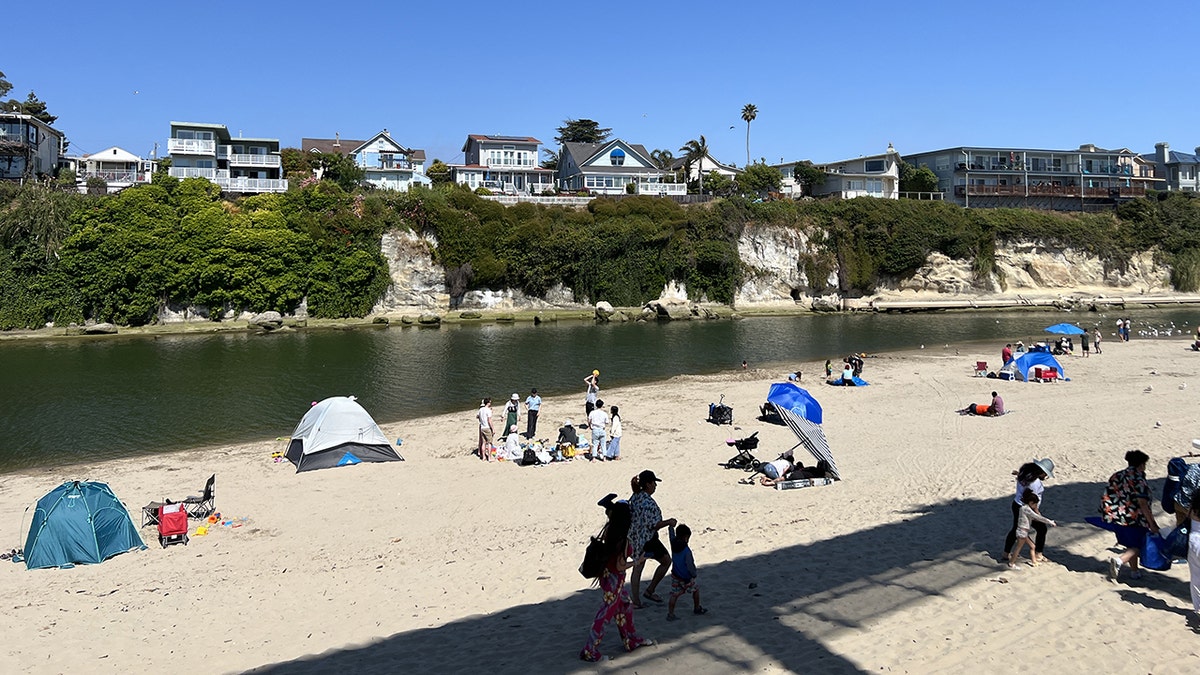
Beachgoers enjoying a sunny day with tents and umbrellas along the coastline, houses situated on the cliff in the background, Santa Cruz, California, June 22, 2024. (Smith Collection/Gado/Getty Images)
“We don’t need a king. We want to go back to the way we were. We want to make America kind again,” said protester Beth Basilius to Lookout Santa Cruz.
While the event promoted “kindness” and inclusivity, the imagery told a more conflicted story.
“They claim they want to make America ‘kind’ again, but then they spell out ‘86 47’ in the sand. That’s not kindness — that’s a coded call to eliminate someone they disagree with. It’s hypocritical,” said Mike LeLieur, chair of the Santa Cruz County Republican Party to Fox News Digital.
LeLieur said local conservatives face growing hostility from the political left.
“We’ve had vehicles vandalized, tires slashed, and windows broken. I was forced off the road and attacked just for having a Trump sticker. At our State of the Union watch party, we were swarmed by angry protesters. It’s been nonstop hostility — and these are the same people who call themselves the ‘Party of Peace.’”
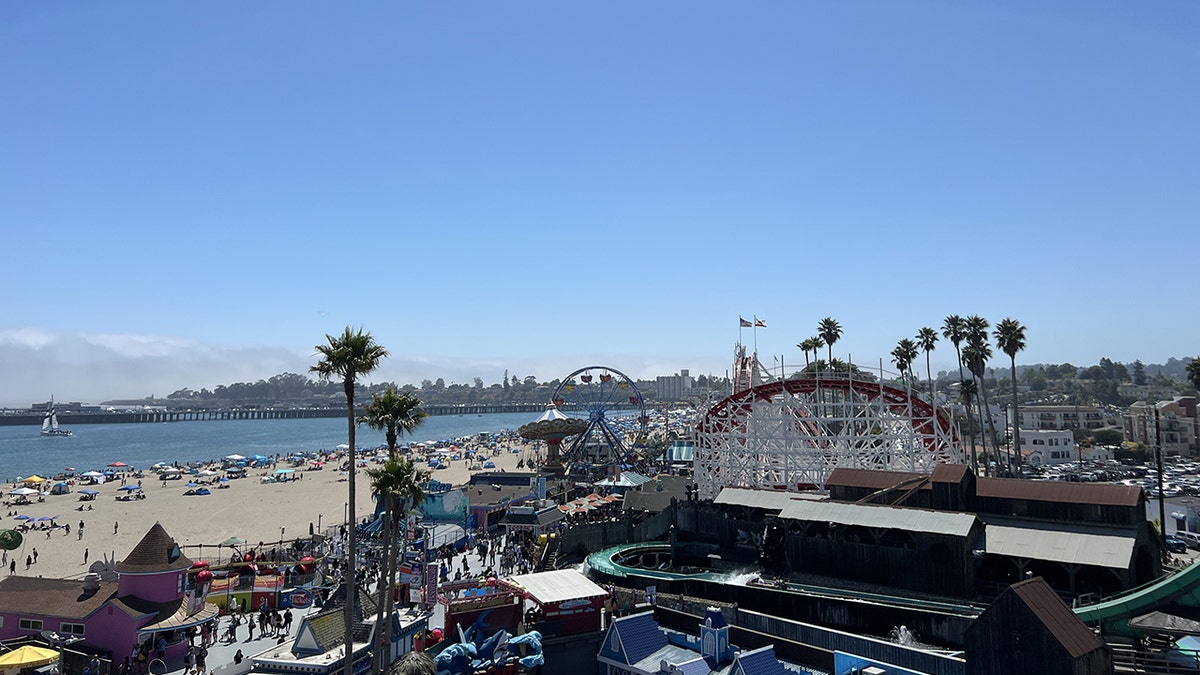
Aerial view of the Santa Cruz Beach Boardwalk with various amusement rides and beachgoers on a sunny day, Santa Cruz Beach Boardwalk, Santa Cruz, California, June 22, 2024. (Smith Collection/Gado/Getty Images)
Just 8.5% of voters in the city of Santa Cruz are registered Republicans, according to the most recent data from the California Secretary of State.
Supporters of the protest claimed that “86 47” was a symbolic rejection of Trump’s agenda, not a literal threat. But critics say that argument falls flat in a political climate where coded language carries real-world consequences.
“In California — and especially in Santa Cruz County — the left is creating a political environment of non-acceptance and persecution,” said Daniel Enriquez, a representative of the California Republican Assembly. “It’s consistent with the goals of socialist movements throughout history.”
Jenny Evans, co-leader of Indivisible Santa Cruz County, defended the event.
“When a great number of people come out to do something like this, it just is one more thing to show that we’re not all saying, ‘Fine, fine. We’ll go along with whatever you want,’” she said to Lookout Santa Cruz.
The event was also part of Santa Cruz’s 50th Pride celebration. Participants were instructed to dress in matching rainbow colors, coordinated with fabric laid out across the beach starting at 7 a.m.
The protest was peaceful, but critics say calling for kindness while displaying “86 47” sent a message that was anything but.
Indivisible Santa Cruz County did not immediately respond to Fox News Digital’s request for comment.
Politics
‘Our own doing’: California Democrats try to figure out how to win national elections again

In the aftermath of Democrats’ widespread electoral failures last year, party activists in California who gathered for their annual convention this weekend struggled with balancing how to stick to their values while also reconnecting with voters who were traditionally part of their base — notably working-class Americans.
California’s progressive policies and its Democratic leaders were routinely battered by Republicans during the 2024 election, with then-vice president and Democratic presidential nominee Kamala Harris taking the brunt of it. Harris ultimately lost the election to Trump, partly because of shrinking support among traditional Democratic constituencies, including minorities and working-class voters.
“We got to be honest in what happened, because losing elections has consequences,” said Minnesota Gov. Tim Walz, Harris’ running mate, during a rousing speech Saturday afternoon. “We’re in this mess because some of it’s our own doing. … None of us can afford to shy away from having hard conversations about what it’s going to take to win elections.”
Walz, a potential 2028 presidential candidate, said Democrats don’t need to retreat from their ideals, such as protecting the most vulnerable in society, including transgender children. But they need to show voters that they are capable of bold policy that will improve voters’ lives rather than delivering incremental progress, he said.
“The Democratic Party, the party of the working class, lost a big chunk of the working class,” he said. “That last election was a primal scream on so many fronts: do something, do something, stand up and make a difference.”
California is home to the most Democrats in the nation as well as a large number of the party’s most deep-pocketed donors, making the state a popular spot for presidential hopefuls from across the country.
In addition to Walz, another potential 2028 White House candidate who addressed the 4,000 delegates and guests at the Anaheim Convention Center was New Jersey Sen. Cory Booker. Booker argued that Democrats must remember the courage of their ancestors who fought for civil and voting rights and created the social safety net for the most vulnerable Americans as they try to fight Trumpism.
“Real change does not come from Washington. It comes from communities. It comes from the streets,” he said in a Saturday morning speech. “The power of the people is greater than the people in power.”
Harris, who is weighing a 2026 gubernatorial run and is also viewed as a potential 2028 presidential candidate, addressed the convention by video. Gov. Gavin Newsom, also viewed as a possible White House contender, did not appear at the convention.
Delegate Jane Baulch-Enloe, a middle school teacher from Pleasant Hill in the Bay Area, said she wasn’t sure that California’s particular brand of liberalism will sell on the national stage.
“I don’t know if a California Democrat can win a presidential election,” she said as she and her daughter sorted through swag and campaign fliers in the convention cafe. “California is thought of as the crazy people. … I don’t mean that in a bad way — though I know some people do — but we do things differently here.”
She said she learned from President Obama’s memoir, “Audacity of Hope,” that most, if not all, Americans “want the same things,” but talk about them differently and have different approaches for getting there. California Democrats, Baulch-Enloe said, “need to get people on our side and help them understand that we aren’t just wacko liberals, and teach people that it’s okay to want things” like healthcare for all and high union wages.
But the 2028 presidential race was not the focus of this year’s California Democratic Party convention. Delegates were more concerned about last year’s presidential and congressional losses — though California was a rare bright spot for the party, flipping three districts held by the GOP — and preparing for next year’s midterm elections. Delegates hope Democrats will take control of Congress to stop Trump from enacting his agenda.
Aref Aziz, a leader of the party’s Asian American Pacific Islander caucus, said the party needed to sharpen its messaging on economic issues if they want to have a chance of victory in coming elections.
“When it comes to the affordability issue, when it comes to economics, those are the things that across the broad spectrum of our coalition, all those things matter to everybody,” Aziz said. “And what really is, what really is important is for us to focus on that economic message and how we’re going to improve the quality of life for everyone in these midterm elections and future presidential elections.”
He noted he was in France on his honeymoon recently, and was strolling through a grocery store and buying half a dozen eggs for 1.50 euros (the equivalent of $1.70) when the news broke that California’s economy had grown to the fourth largest in the world.
“When you look at a lot of our economies, California and New York, by all accounts, GDP, the numbers that you look at, they’re doing great,” he said. “But when it comes to the cost that consumers are paying in these places, they’re so high and so far above other countries that we end up diminishing whatever value there is in our GDP, because everything’s so expensive.”
Some Democrats questioned the impact of the weaponization of California’s liberal policies, including defending transgender rights, on voters in battleground states in 2024.
But delegates and party leaders largely argued that the state needs to continue to be on the vanguard of such matters.
“People like to point a finger somewhere, and I think California is an easy target, but I disagree,” said delegate Melissa Taylor, president of Foothill Community Democrats. “Because I think that California is standing up for values that the Democratic Party believes in, like we believe in labor, we believe in healthcare, we believe in women’s rights, we believe in rights for LGBTQ people.”
Jodi Hicks, the president of Planned Parenthood Affiliates of California, said issues such as reproductive healthcare access also have an economic impact.
“We have to walk and chew gum at the same time,” she said, adding that the party’s 2024 losses were likely prompted by multiple factors, including Harris’ being the Democratic nominee for a little over three months after then-President Biden decided not to seek reelection.
“We’re going to be analyzing 2024 for a very long time,” Hicks said. “It was such unique circumstances.”
Times staff writer Laura J. Nelson contributed to this report.
Politics
Senate Republicans eye changes to Trump's megabill after House win

House Republicans eked out a win in May with their advancement of President Donald Trump’s “big, beautiful bill,” filled with negotiations and compromises on thorny policy issues that barely passed muster in the lower chamber.
Next week, Senate Republicans will get their turn to parse through the colossal package and are eying changes that could be a hard sell for House Speaker Mike Johnson, R-La., who can only afford to lose three votes.
INSIDE THE LATE-NIGHT DRAMA THAT LED TO TRUMP’S TAX BILL PASSING BY 1 VOTE
President Donald Trump listens to a question during an event to present law enforcement officers with an award in the Oval Office at the White House on May 19. (AP Photo/Manuel Balce Ceneta)
Congressional Republicans are in a dead sprint to get the megabill — filled with Trump’s policy desires on taxes, immigration, energy, defense and the national debt — onto the president’s desk by early July.
Trump has thrown his support behind the current product, but said during a press conference in the Oval Office on Friday that he expected the package to be “jiggered around a little bit.”
“It’s going to be negotiated with the Senate, with the House, but the end result is it extends the Trump tax cuts,” he said.
“If it doesn’t get approved, you’ll have a 68% tax increase,” the president continued. “You’re going to go up 68%. That’s a number that nobody has ever heard of before. You’ll have a massive tax increase.”
Senate Majority Leader John Thune, R-S.D., has an identical margin to Johnson, and will need to cultivate support from a Senate GOP that wants to put its own fingerprints on the bill.
Senators have signaled they’d like to make changes to a litany of House proposals, including reforms to Medicaid and the timeline for phasing out green energy tax credits, among others, and have grumbled about the hike to the state and local tax (SALT) deduction cap pushed for by moderate House Republicans.
SCOOP: HOUSE GOP MEMO HIGHLIGHTS REPUBLICAN WINS IN TRUMP’S ‘BIG, BEAUTIFUL BILL’
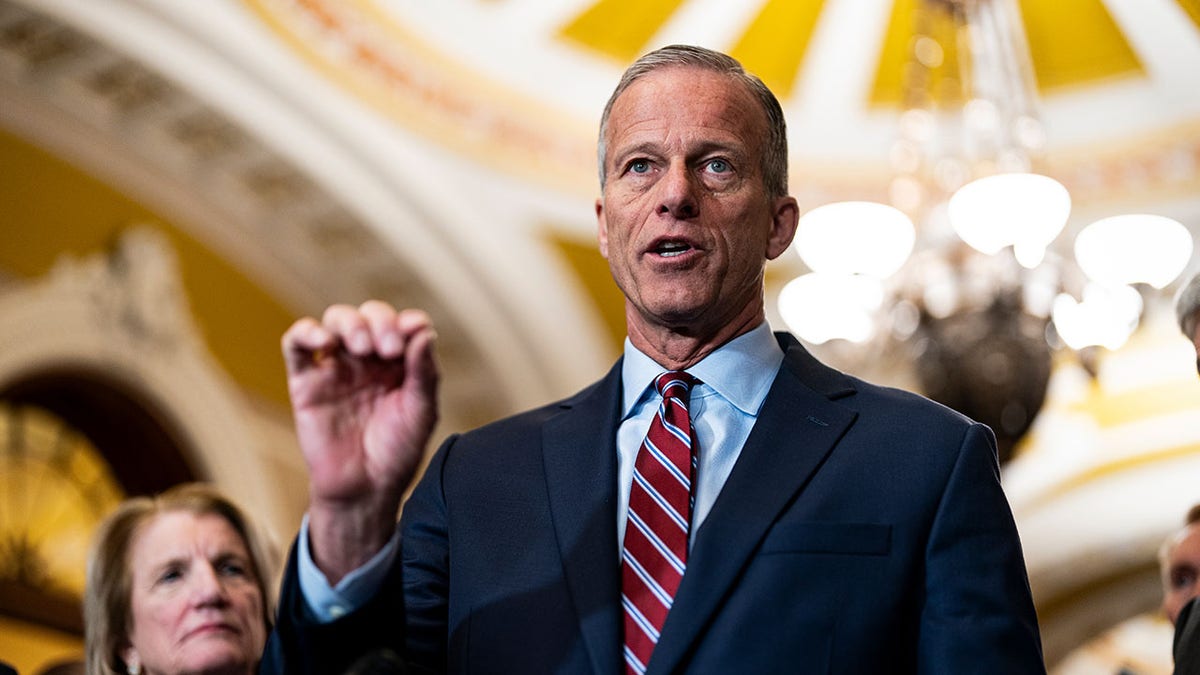
Senate Majority Leader John Thune speaks during a news conference following the Senate Republican policy luncheon at the U.S. Capitol on March 11. (Al Drago/Bloomberg via Getty Images)
Thune said many Republicans are largely in favor of the tax portion of the bill, which seeks to make Trump’s first-term tax policy permanent, and particularly the tax policies that are “stimulative, that are pro-growth, that will create greater growth in the economy.”
Much of the debate, and prospective tweaks, from the upper chamber would likely focus on whether the House’s offering has deep enough spending cuts, he said.
“When it comes to the spending side of the equation, this is a unique moment in time and in history where we have the House and the Senate and the White House and an opportunity to do something meaningful about controlled government spending,” Thune said.
The House package set a benchmark of $1.5 trillion in spending cuts over the next decade.
Some in the Senate GOP would like to see that number cranked up marginally to at least $2 trillion, largely because the tax portion of the package is expected to add nearly $4 trillion to the deficit, according to recent findings from the Joint Committee on Taxation.
“There’s just so many great things in this bill,” Sen. Roger Marshall, R-Kan., told Fox News Digital. “The only thing I would like to do is try to cut the spending, and I would love to take a little bit from a lot of places, rather than a lot from just one place.”
SPEAKER JOHNSON CLASHES WITH RAND PAUL OVER ‘WIMPY’ SPENDING CUTS IN TRUMP’S BILL
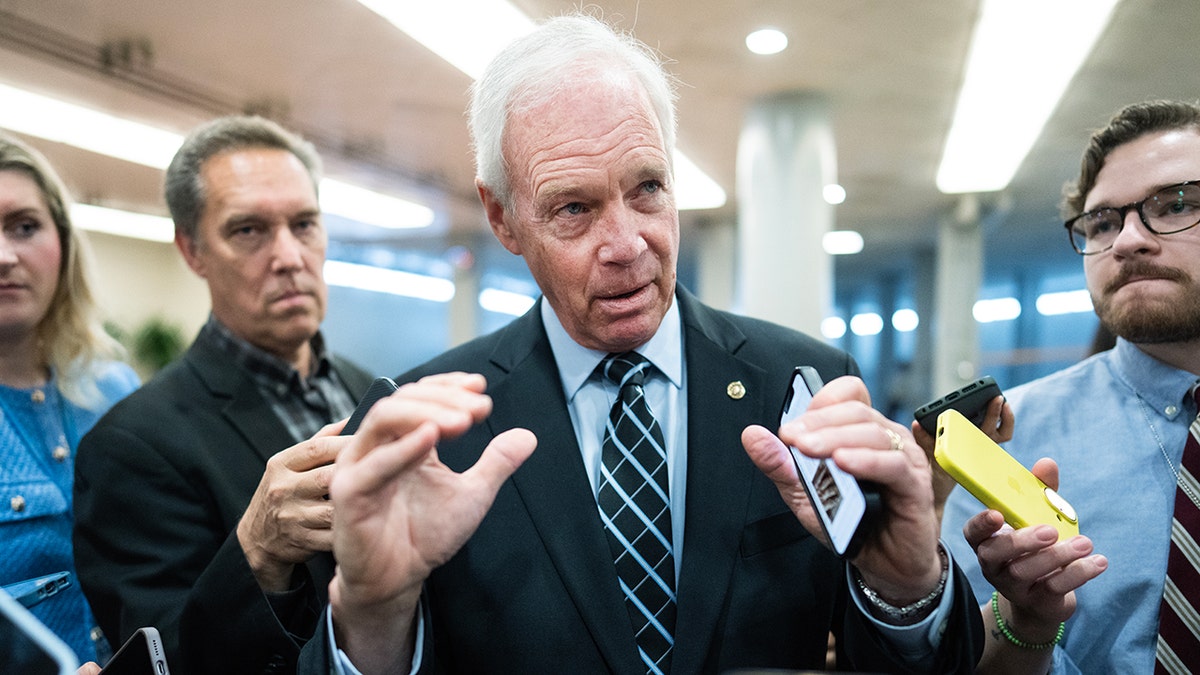
Sen. Ron Johnson talks with reporters in the U.S. Capitol in Washington, D.C., after the House passed the One Big Beautiful Bill Act on May 22. (CQ-Roll Call, Inc via Getty Images)
Others, like Sen. Ron Johnson, R-Wis., want to see the cuts in the package return to pre-pandemic spending levels, which would amount to roughly a $6 trillion slash in spending.
Johnson has remained unflinching in his opposition to the current bill, and warned that “no amount of pressure” from Trump could change his mind.
“President Trump made a bunch of promises,” Johnson said at an event in Wisconsin on Wednesday. “My promise has been, consistently, we have to stop mortgaging our children’s future. OK, so I think there are enough [Republicans] to slow this process down until the president, our leadership, gets serious about returning to a pre-pandemic level.”
Others are concerned over the proposed slashes to Medicaid spending, which congressional Republicans have largely pitched as reform efforts designed to root out waste, fraud and abuse in the program used by millions of Americans.
The House package would see a roughly $700 billion cut from the program, according to a report from the nonpartisan Congressional Budget Office (CBO), and some Senate Republicans have signaled that they wouldn’t support the changes if benefits were cut for their constituents.
Sen. Josh Hawley, R-Mo., warned in an op-ed for The New York Times last month that cutting benefits was “both morally wrong and politically suicidal.” Meanwhile, Sen. Susan Collins, R-Maine, raised concerns about what proposed cuts to the program would do to rural hospitals in her state.
“I cannot support proposals that would create more duress for our hospitals and providers that are already teetering on the edge of insolvency,” she said.
-
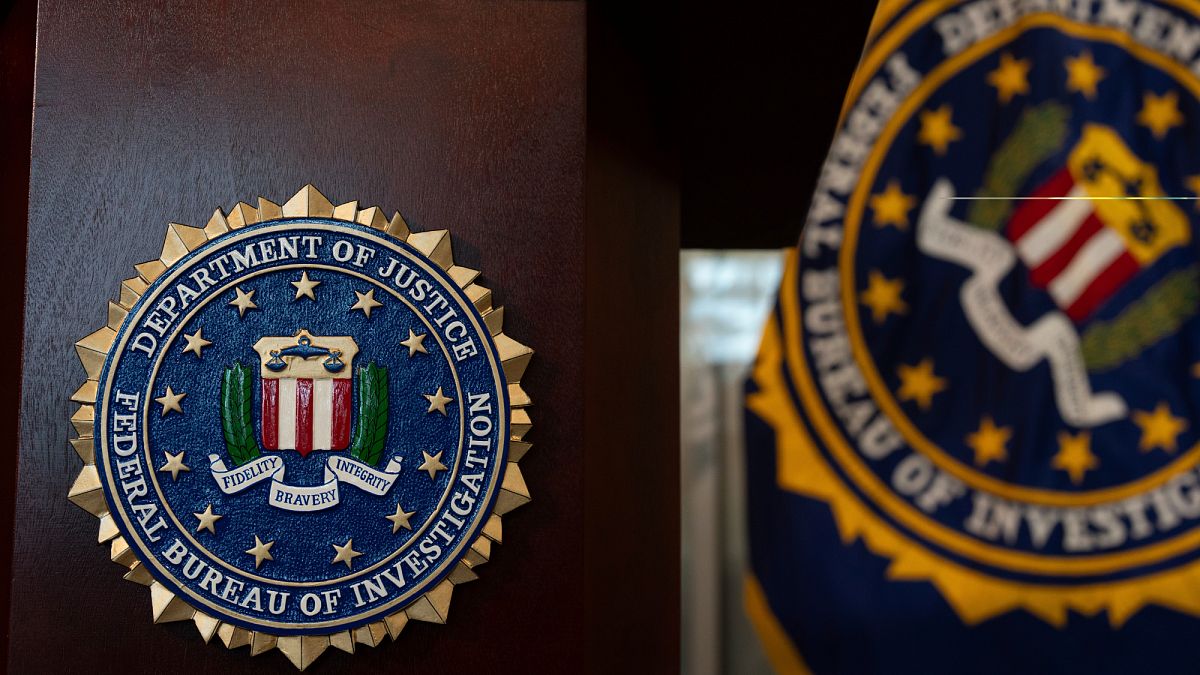
 World1 week ago
World1 week agoNeo-Nazi cult leader extradited to US for plot to kill Jewish children
-

 Business1 week ago
Business1 week agoPlastic Spoons, Umbrellas, Violins: A Guide to What Americans Buy From China
-

 Movie Reviews7 days ago
Movie Reviews7 days agoMOVIE REVIEW – Mission: Impossible 8 has Tom Cruise facing his final reckoning
-

 World1 week ago
World1 week agoCade Cunningham Gains $45 Million From All-NBA Honors
-

 Movie Reviews1 week ago
Movie Reviews1 week agoKapkapiii movie review: Horror-comedy signals a saturation point for the genre
-

 Movie Reviews1 week ago
Movie Reviews1 week ago‘Magellan’ Review: Gael Garcia Bernal Plays the Famous Explorer in Lav Diaz’s Exquisitely Shot Challenge of an Arthouse Epic
-

 Rhode Island1 week ago
Rhode Island1 week agoAssessors find ‘nonconformities’ with national standards at RI Crime Lab. What to know.
-

 Education1 week ago
Education1 week agoVideo: Judge Blocks Trump Move to Ban Foreign Students at Harvard





